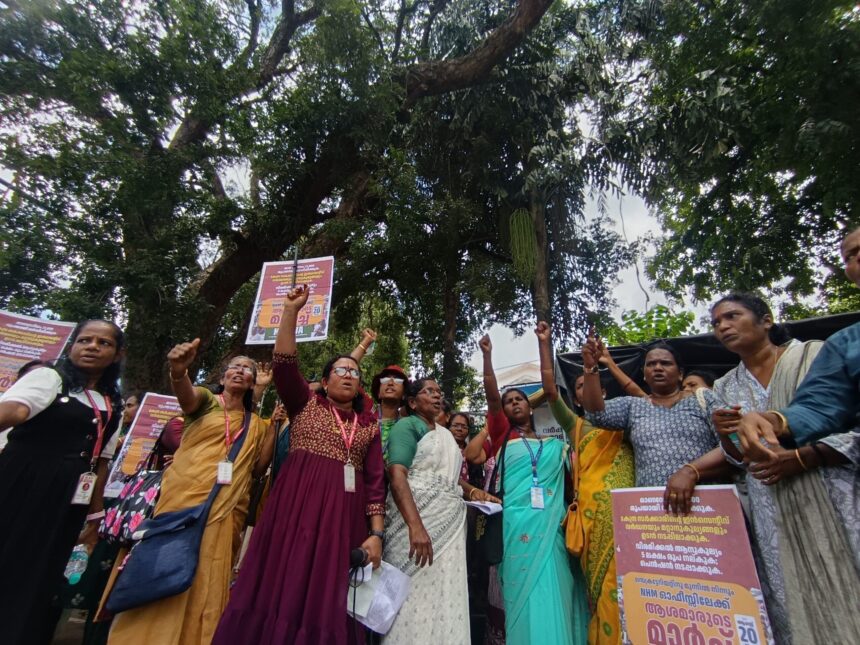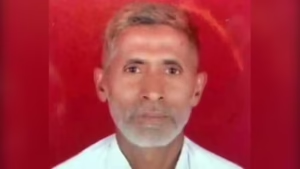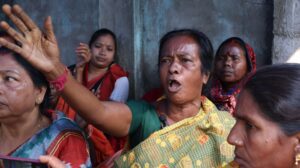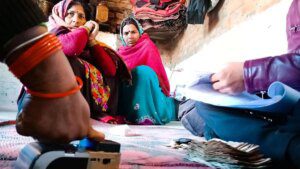Anamika A, Archana Ravi, Ayana Krishna D, J Devika, Divya G S, Gayatri Devi, Shraddha Jain, Shradha S and Srimanjori Guha
[This piece was written in response to a flagrant misrepresentation of the ASHA workers’ ongoing struggle in Kerala, by Binitha Thampi and Varsha Prasad, which appeared in the Economic and Political Weekly early this month, titled “Labouring on the Margins: ASHA Workers’ Protests in Kerala and Working-class Solidarities” (Oct.4, 2025, LX, 40, 13-17). A group of us — scholars, activists, artists and others who have been closely following the struggle since its beginning — wrote a rejoinder to it. The EPW editor verbally agreed to consider it, but the edit desk insisted that it be subjected to the same peer-review process (as their special articles, it seemed). Commentary pieces, as those who have published in the EPW earlier know, were dealt with at the editorial desk, and the editor was back then obviously competent to judge whether a rejoinder to a commentary piece was a fair one or not. Now that seemingly requires a review process! That does not suit us simply because this atrocious piece of slander is aimed at an ongoing struggle, at the lives of struggling women workers, by other women steeped in academic, social, and political privilege. There is, then, the need to respond quickly, to defend the struggle from the verbal equivalent of a shower of stones thrown at it. At the same time, the very fact that B Thampi’s and V Prasad’s piece, which parrots the CPM troll position in each line and trips over themselves several times empirically and theoretically, has clearly not been subjected to peer-review by the same EPW editorial, for it would definitely would not have got published like it is now — biased in the extreme.
So we have decided to share our rejoinder here. We are sorry to see that the editorial desk at EPW is either incapable of shouldering editorial responsibility, or is actively promoting the one-sided, pro-CPM, anti-woman worker narrative.]
A commentary is a concise, principled opinion piece that examines a specific issue with the aim of adding depth, offering new perspectives, and shaping public debate. While it may reflect the author’s viewpoint, the argument should be rigorously grounded in relevant information and realities, and avoid flippancy or distortions to fit a predetermined stance. The commentary by Binitha Thampi and Varsha Prasad for the Economic and Political Weekly titled “Labouring on the Margins: ASHA Workers’ Protests in Kerala and Working-class Solidarities” (Oct.4, 2025, LX, 40, 13-17) which claims to be an attempt to throw new light on the ongoing ASHA workers’ protest in Kerala makes numerous logical fallacies which lead them to reach the brazen conclusion that “Although advocating for improved wages is crucial, emphasizing only one group and asserting that the nature of their work warrants higher pay may undermine broader collective action”. We believe that this is typical of a pro-government view that hides behind apparent academic neutrality and social scientific objectivity wherein the researcher/expert would cherry-pick information and theories to suit the government’s stand and present them in a language that appeals to the liberal readers too. The authors’ apparent appeasement of the government not only trivializes the everyday life and work struggles of tens of thousands of resource-poor ASHA workers, it also undermines the potential of this protest to become a pivotal source of feminist solidarity in Kerala and across the country.
Instead of dismissing Thampi and Prasad’s arguments, we engage with them in this piece to examine and dissect their logical fallacies, while highlighting the broader aim of deepening the public discourse they have overlooked in their analysis. As a group of women who have been in critical solidarity with the workers’ struggle since almost its earliest days, our intention is to mobilize further support for the ASHA workers’ protest and persuade the government to negotiate with the workers with a principled and moral obligation to redress their grievances.
We first address the authors’ adherence to the national health mission guideline that ASHA workers are “honorary women volunteers”. It has been well established that the state extracts cheap labour out of resource-poor women’s ‘volunteering’ to deliver neoliberalised welfare services cheaply. However, how can their labour be referred to as voluntary work from a labour rights perspective? Volunteerism as a concept presumes that the individual has complete autonomy over when to enter and exit from their altruistic role, and have the agency to choose which activities to perform and when. These women who are mainly from resource-poor families and often single women heads of households, carry the triple burden of providing care and health services to other such families, while maintaining the community infrastructure to which the state has the primary duty of care. When these women reject the label of volunteers, demand that their labour be recognised with adequate wages, and complain that they are exploited by the state, how can the authors continue to refer to them as “voluntary” workers?
Secondly, the authors make certain comparisons between ASHA workers and other categories of informal sector women delivering services to citizens, like, for instance, the waste-collectors called the Haritha Karma Sena (sanitation workers), to point to a convergence of duties. They argue that despite both these sectors sharing similarities, the ASHA workers are now singling themselves out as a distinct category and demanding higher wages — a strategy which the authors believe breaches the true spirit of working-class solidarity. It is fallacious thinking that assumes women workers in Kerala’s informal sector to be a homogenous category. For instance, the authors mention ‘Kudumbashree workers’ along with other categories of government care workers – though it is well-known that Kudumbashree women’s self-help groups were constituted not as a class of workers, but as the local-level development and civil society for women. We agree that they are often used to perform under-paid and unpaid development and governmental labour, but they cannot be collapsed with ASHA workers.
Another important articulation from the ASHA workers protest is that they perform skilled work through the experience gained from hours of rigorous training — a fact that the Haritha Committee Report (HCR) (set up by the Kerala government to study the issues raised by the striking workers) acknowledges. Moreover, their work also goes beyond providing health care services and includes affective labour that provides palliative care to the rising elderly population in this state, in addition to the maternal and child healthcare and frontline care for diseased patients (again, well-acknowledged by the HCR) . ASHA workers in Kerala have undergone at least 9 rounds of training modules, since they were introduced in the state in 2007 apart from additional training in various communicable diseases and their responsibilities are far from being “non-specialist” as the article claims. They are indeed the key sources of primary health information; they memorialise across generational timelines at hyper-local levels, with even elected officials referring to them for public health data. The Kerala government launched its well-known Aardram Mission piggybacking on the deep social connections that ASHA workers built in their communities. It is such connections which allowed them to carry out Shaili, the state government’s elaborate population enumeration survey for non-communicable diseases. The elaborate questionnaire even had questions about intimate matters, but the workers managed to glean information that would not normally be shared.
Each work and worker cohort must be evaluated based on the nature of labour and the unique conditions under which that labour is performed. In other words, the comparison attempted by the authors is false. ASHA workers deliver specific, specialised services for which they receive specific training, and ad-hoc instances of other women workers carrying out some of their tasks (mentioned by the authors) does not invalidate this. Next, the claim that in a situation in which several groups of women are oppressed by patriarchy, those groups which achieve critical awareness and protest against oppression are in effect against their co-sufferers, is an intensely patriarchal one. It echoes the logic of the common patriarchal dismissal of women protesting against patriarchy, that they should not be heard until they prove that they represent all women suffering similarly from patriarchy. At this point, one must question whether this position arises from a genuine concern for working-class struggles or merely serves to trivialise the struggle through a form of whataboutery.
The conceptualisation of Kerala’s state-mobilized female public care workforce as “a huge reserve army of informal women care workers, whom the state has mobilised and kept” is very interesting, especially in the light of a recent press conference by the Minister for Local Self-Goverment M B Rajesh (10 Oct. 2025), in which he announced that the Kerala government would “hold hands” with Reliance Jio to create 10,000 (low-skill, relatively low paid) jobs for Kudumbashree women. However, Thampi and Prasad are more worried that a section of care workers might actually force the government to address the plight of the “reserve army” – we can hardly help saying that this is an odd claim, especially by authors use left-leaning academic language about labour!
The authors seem to be more worried about the government than about workers in other instances too. Suppose the ‘Kudumbashree workers’ who serve the local self-government so cheaply gain political awareness and decide to join hands with the ASHA workers to demand better wages and recognition. According to the logic of the authors’ concern, that would be a calamity. There is every reason, we think, to believe that these authors employ the strike busting tactic of capitalists despite their neutral-academic self-presentation: and most importantly, their slander about the protesters in “not challenging the Central government, and their ostensible friendship with a BJP MP”! These lies have been contested repeatedly by the protest leaders and others, and it is baffling how these authors who claim to be field researchers can simply parrot them so blithely.
Thirdly, the ASHA workers who apparently claim to be “a distinct category uniquely deserving of higher wages,” are only asking for a living wage, as they get a measly Rs. 233 per day as their monthly honorarium. Not only do the authors insinuate maliciously that the ASHAs seek to cut themselves off from others and seek higher moral ground, they also ignore the open solidarities that the protesters announced with other strikes of anganwadi workers, school mid-day meal cooks and the young women on the rank list striking for appointments as civil police officers over the past months! This is a deliberate misrepresentation of the protest; as activists and researchers who have been closely observing the protest since its inception, we reject them. The repeated comparisons of various working class peoples, with the intention of giving no one a pay hike, reminds one of feudal Travancore where Dalit farm workers were paid very little wages, but some Dalit workers were paid even less. It is clear that such comparison is with the intention of dividing the working class, who would otherwise align with each other organically.
It is thus hard to believe that the authors, who claim to have done field work among these workers, did not see the significance of these differences between these women worker-groups. Yet they persist in homogenizing them – why? In addition to the nature of their work being vastly different, there is also another important detail regarding the caste and class of ASHA workers. A majority of ASHA workers come from OBC communities. However, at the protest site, a significant number of the striking workers were the only bread winners in their families, and there was an overrepresentation of Dalit workers. The attempted homogenisation that conveniently overlooks the striking workers’ social backgrounds echoes the state’s position and thus erases the structural inequalities that shape their lived realities. One can only read this as an expression of bad faith. This seems evident from the apprehension they express – the exact apprehension as the government-oriented HCR – that conceding the workers’ demands would place a high fiscal burden on the government (“with elections imminent”, the authors add, thoughtfully). Both the HCR and these authors ignore the very dense public debate in Kerala on precisely this concern – and how many interlocutors, for example, the well-known economist K P Kannan, have countered this argument. It then appears that the real concern is that ASHA workers should not protest against their exploitation because the authors fear, just like the government does, that this may open a can of worms!
Fourthly, the authors argue that the ASHA workers somehow consider themselves superior to other working-class women because “the pandemic helped ASHAs build a newfound emotional proximity, traction and social acceptance, particularly among middle-class households, and consequently, reconfigured their public position/status vis-à-vis other informal women workers.” And that it is this social mobility that they are exploiting to demand for higher wages. The authors impose their elitist gaze on the resource-poor women in the state to undermine the workers’ agency. Even more maliciously, they claim that the support that they received has been from a maudlin middle-class which apparently fell for the sentimental appeal! A large number of women and men from across caste, class, political ideologies have extended their support to the protesting ASHA workers not because they wish to pay off some debt of gratitude to the ASHA workers who took care of them during the pandemic, but because they are citizens from Kerala who care about public health, workers’ rights, Kerala’s unique history of social democratic welfarism and policy-making, and the very future of this state in a context of increasing socio-economic inequalities. In fact, even when the larger male-dominated trade unions like CITU made sexually-coloured, slandering remarks against the protesting workers, international trade union organisations like the Public Services International, ITUC, UNI as well as other independent workers’ unions in India, also of exclusively women workers, came out in support of the ASHA workers petitioning directly to the Chief Minister of Kerala to legitimise their demands.
ASHA workers do not need the advice of ‘middle-class’ or ‘activists’ or indeed, academics, to lecture them on how to protest or forge alliances. The protesting ASHA workers have brought down every accusation against them with logical arguments and data and articulating their needs and demands very clearly, publicly, in TV shows, throughout March and April 2025, even when all efforts were made to ridicule them. Another effect of dubbing the public support to the strike ‘middle-class’ is to hide the fact that the support came in the larger measure from Kerala’s oppositional civil society, not just some ‘middle-class’. Feminist groups downed their differences to offer support; leading CPM-friendly intellectuals openly broke with the government to sign petitions, make speeches, and write articles in support of the protest; public health scholars and students wrote in the Malayalam and English press refuting the government’s claims; Kerala’s People’s Science Movement which has been close all through its history to the mainstream communist parties issued a statement asking for speedy and sympathetic government response. The use of ‘middle-class’ and not ‘politicised/oppositional civil society is but a conceptual choice that aims at opacity, not lucidity!
Equally disappointing is the authors’ eagerness to portray as apolitical charity, the campaign that called upon the supporters of the protest to help the workers (whose remunerations were being delayed or denied) by adding a thousand rupees per month to their monthly honoraria. This is yet another move that renders invisible the civil social effort which highlighted the meanness that the state and the ruling CPM continued to defend doggedly, even as the protest dragged on. Charity is a flow of resources from the powerful to the powerless, which is not the right of the latter, but the benevolence of the former. Far from being so, the 1000/month for ASHAs campaign was an open declaration of allyship by Kerala’s oppositional civil society and workers which strove to draw the government’s attention to the extremely poor remuneration received by workers whose contribution to public health is beyond question. If the authors do not see this, it is because they use the lenses of Kerala’s dominant left – which pretends that oppositional civil society does not exist and all they have to deal with is a vaguely-understood ‘middle-class’. Also, because they have little familiarity with the struggle as it actually unfolded, the authors did not probably notice how much the working class of Thiruvananthapuram contributed to the strike fund. Every single day, women hawkers, autorickshaw drivers, retired headload workers, and other working class visitors to the strike site made small daily contributions to the strike fund. That may not be visible when one starts with pre-conceived notions about the protesters.
Finally, the authors write “Despite high visibility, the protest marks limited participation with only a small fraction of ASHA workers in the state actively involved in the agitation. Furthermore, the strike launched in Thiruvananthapuram failed to lead to parallel mobilisations of a similar scale in other parts of Kerala. These clearly undermine KAHWA’s claim of being a broad-based workers’ collective.” In the eight months of this protest, it has mobilised above 15,000 workers across districts, including the state-wide 45 day protest march. But it is pertinent to challenge the assumption that the legitimacy of a protest must be measured in terms of the number of people who join it. All resistance movements for women’s rights across the globe have been a minority-led movement, and yet all of us including the authors have benefited from the wins of these minority-led movements. Democratic ethics demand that attention be given to the reasoning, evidence and impact behind the demands rather than do a tally of the bodies on the streets. It also shows the need to remind the authors of the history and theory of labour rights organising, where workers at the frontline ally with strike organisers and civil society who join the picket in solidarity and transparency, not as performance or with hidden agendas. In any case, the responsibility of building solidarity should not fall on a group of workers who are already marginalized. Indeed, the ASHAs’ protest could grow into a movement that can be a potential pathway towards building new working-class solidarities.
In conclusion, we wish to register our dismay and protest at such a blatant attack on an ongoing struggle of women workers. Despite their use of Marxist-feminist terminology, the authors’ characterisation of the protest is far from any Marxist-feminism; indeed, neither Marxist nor feminist, they seem to be using the intellectual apathy stemming from the hardline response of technocratic left government, which seems keener every day to suppress dissent and denigrate women workers’ struggles. Their development agenda attempts to savour the prospect of treating the government-mobilized care-worker force of Kerala into precisely a reserve army of labour – for the benefit of Reliance, Amazon, Flipkart and other corporation giants (as M B Rajesh’s press note gloats). Maybe ASHA workers will be asked to join private sector conglomerates in health care as their foot-soldiers – and combine their public health work with underpaid labour for capital and surveillance in health care. The HCR seems to already sow the seeds of such a prospective development. We believe that the ongoing protest must win at all costs, rooted as we are in both women workers’ rights and the future of public health in Kerala – and so are compelled to debunk this propaganda piece, no matter how much it tries to disguise itself in academic neutrality.
Anamika A, Independent feminist scholar, Althea Women’s Collective.
Archana Ravi, Independent journalist and artist.
Ayana Krishna D, Doctoral Scholar, Centre for Development Studies, Kerala.
J Devika, Professor, Centre for Development Studies, and Althea Women’s Collective.
Divya G S, Research Scholar, TISS, Mumbai and Althea Women’s Collective.
Gayatri Devi, Professor, Savannah College of Art and Design, USA and Althea Women’s Collective.
Shraddha Jain, Doctoral Scholar, Centre for Development Studies.
Shradha S, Independent Researcher, Kerala.
Srimanjori Guha, Doctoral Scholar, Centre for Development Studies.
This was originally published on Kafila.
The post Countering propaganda against the ASHA workers’ struggle in Kerala: A rejoinder to the EPW article appeared first on Maktoob media.










